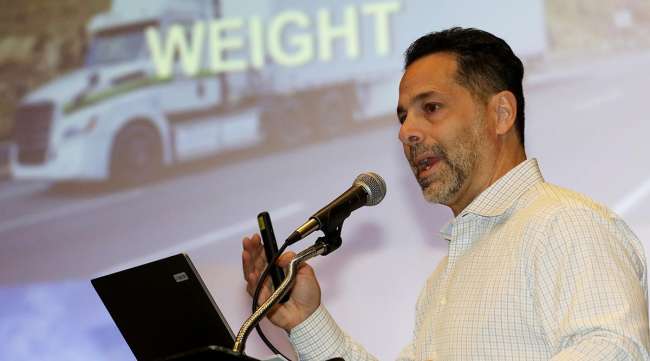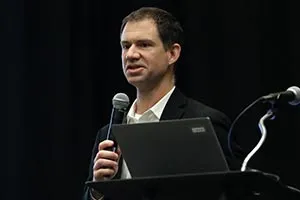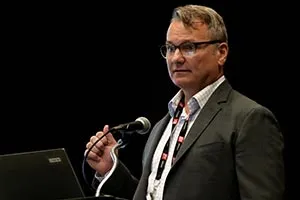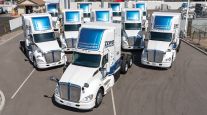Managing Editor, Features and Multimedia
‘Driving in a Fog’: Fleets Face Complex Equipment Choices

[Stay on top of transportation news: Get TTNews in your inbox.]
AUSTIN, Texas — Trucking fleets’ equipment purchasing decisions are becoming more complex than ever amid overlapping and rapidly shifting truck emissions regulations at the federal level and in California.
The diesel engines that have powered the industry for generations will continue to evolve, but fleet operators also will be able to choose from an expanding list of powertrain options, including battery-electric and hydrogen fuel cell trucks and alternative fuels for combustion engines.
In the coming years, truck and engine makers will need to meet increasingly stringent limits for nitrogen oxide and greenhouse gas emissions along with California’s zero-emission vehicle mandates under the state’s Advanced Clean Trucks and Advanced Clean Fleets rules.
Industry executives discussed the implications of these new regulations from the U.S. Environmental Protection Agency and California’s Air Resources Board during an Oct. 14 educational session here at American Trucking Associations’ 2023 Management Conference & Exhibition.
Planning future equipment purchases in response to the upcoming emissions regulations is like “driving in a fog,” said Paul Rosa, senior vice president of procurement and fleet planning at Penske Truck Leasing.
A panel discussion at #ATAmce23 is under way on how fleets can navigate the increasingly complex emissions regulations for commercial trucks as they plan future equipment purchases, especially in California. pic.twitter.com/MjbDdXG4z0 — Seth Clevenger (@SethClevenger) October 14, 2023
“We don’t quite know what’s ahead for us,” he said. “We don’t know what we have to be prepared for, or what are we up against.”
It’s very challenging for fleets to make sound decisions when the regulatory “goal line” keeps moving, Rosa added.
In addition to the regulatory changes, fleets also must deal with uncertainty regarding the cost, availability and durability of future equipment options.
In this environment, carefully planned strategies for future vehicle purchases can become obsolete shortly after completing them, Rosa said. He illustrated the point by crumpling up paper printouts representing plans Penske developed earlier this year after weeks of work but are no longer relevant.
“I hope that fog clears up sometime soon so sounder decisions can be made with the right information — the complete information,” Rosa said.
What fleets need is a “clear drive” where they can see the turns ahead and prepare for them, he said. “There will be hills and there will be things to overcome, but we’ll be able to do it with a clear path forward.”

Waters by John Sommers II for Transport Topics
Truck makers have begun producing battery-electric trucks in recent years while also investing in hydrogen fuel cell technology as part of their efforts to make zero-emission trucking a reality.
Daimler Truck, which manufactures Freightliner and Western Star trucks and Detroit engines in North America, aims to achieve net carbon neutrality for its new commercial vehicles by 2039.
“We know we have a huge challenge in front of us, but I’m optimistic, and we will get there,” said Sean Waters, vice president of product compliance and regulatory affairs at Daimler Truck North America.
He said the successful rollout of zero-emission commercial vehicles will hinge on three key criteria: the introduction of viable zero-emission trucks, total cost of ownership parity with diesel and the availability of dependable infrastructure.
While all major truck manufacturers already have introduced battery-electric models, the cost of these vehicles and establishing the charging infrastructure to support them remain challenges.
“Electric trucks today are expensive,” Waters said. “That’s not a secret to anyone. There are a lot of government incentives out there but there’s certainly more work to do to get the price of the product down so there is a positive business case for our customers.”
However, Waters pointed to charging infrastructure as the biggest roadblock for electric truck deployments to date.
“We have to acknowledge some of the problems and acknowledge some of the challenges, and then we can work on the solutions,” he said.
On the regulatory front, CARB’s ACT rule could limit the availability of new diesel trucks in California as soon as next year.
Starting in 2024, truck manufacturers are required to sell a percentage of zero-emission vehicles based on their annual sales volumes of vehicles produced and delivered for sale in California.
DTNA will comply with this requirement by allocating its diesel truck volumes based on its zero-emission vehicle sales, Waters said. “There are going to be some limitations in terms of diesel availability starting as early as 2024 under the ACT rule.”
Rosa also voiced concerns about the availability of new diesel equipment.
“There are not going to be enough trucks for California, plain and simple,” he said.

Spears by John Sommers II for Transport Topics
In the near term, the industry must navigate “much greater complexity” to ensure fleets deploy compliant engines in California in 2024, said Matt Spears, executive director for regulatory affairs at engine maker Cummins Inc.
When ordering new equipment, fleets will need to answer a series of questions to specify in which state a new truck will be registered, whether it will be regulated under CARB’s ACF rule and whether it will need a CARB clean idle label, he said. The answers to those questions will determine if an EPA-only engine will be compliant or if the customer will need to purchase an engine that meets CARB’s requirements.
“It has gotten more complex than it ever has been in the past,” Spears said.
Meanwhile, UPS Inc. is eager to remind policymakers that battery-electric and hydrogen vehicles are not the only path toward reducing emissions.

Okuyiga by John Sommers II for Transport Topics
Andrew Okuyiga, UPS’ vice president of public affairs, highlighted the company’s use of renewable natural gas as it works toward its long-term environmental sustainability goals.
Among the numerous alternative fuels that UPS is actively testing in its ground fleet, RNG produced at dairy farms has been the package delivery giant’s most effective tool for reducing carbon emissions from its ground fleet, Okuyiga said. RNG recovered from cow waste offers a net negative carbon intensity rating because it effectively removes more carbon dioxide from the atmosphere than it creates.
During the past decade or so, government regulations have incentivized or encouraged the use of RNG, he said, but upcoming regulations such as CARB’s ACF rule and some of EPA’s proposed standards do not accommodate this alternative fuel.
“If they are enacted as is, [these regulations] will force us to move from our most effective way to remove carbon from our network to less effective, more expensive ways to do it,” Okuyiga said. “Even as we continue to pilot some of the electric and hydrogen solutions, RNG remains our most important tool.”
Want more news? Listen to today's daily briefing below or go here for more info:





